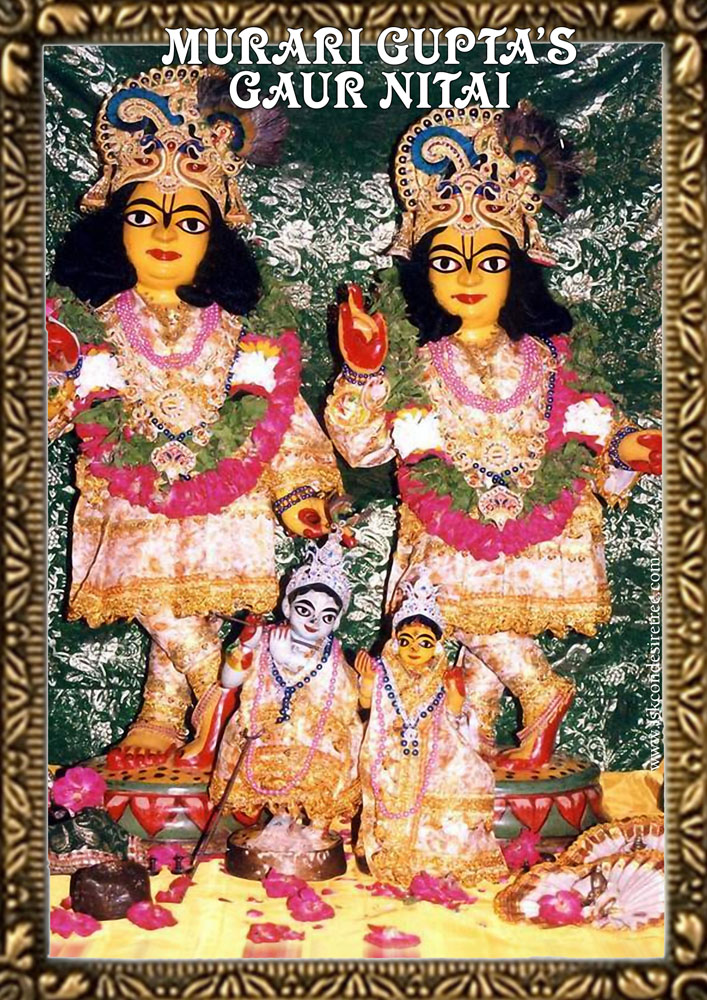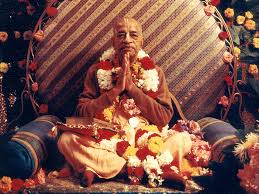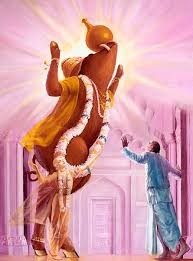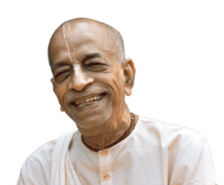

Murari Gupta’s deities of Sri Caitanya Mahaprabhu
Sri Murari Gupta Tirobhava tithi [disappearance day]
Sunday, October 16, 2016 [Mayapura, West Bengal, India time]
Srila Prabhupada explains the glories of Sri Murari Gupta
advaita ācārya, nityānanda, śrīnivāsa
gadādhara, dāmodara, murāri, haridāsa
āra yata caitanya-kṛṣṇera bhakta-gaṇa
bhakti-bhāve śire dhari sabāra caraṇa
SYNONYMS
advaita ācārya—Advaita Ācārya; nityānanda—Lord Nityānanda; śrīnivāsa—Śrīvāsa Paṇḍita; gadādhara—Gadādhara Paṇḍita; dāmodara—Svarūpa Dāmodara; murāri—Murāri Gupta; haridāsa—Haridāsa Ṭhākura; āra—other; yata—all; caitanya-kṛṣṇera—of Śrī Kṛṣṇa Caitanya; bhakta-gaṇa—devotees; bhakti-bhāve—with a devotional attitude; śire—on my head; dhari—I take; sabāra—of all of them; caraṇa—the lotus feet.
TRANSLATION
Bowing down with devotion, I hold on my head the lotus feet of Advaita Ācārya, Nityānanda, Śrīvāsa Paṇḍita, Gadādhara, Svarūpa Dāmodara, Murāri Gupta, Haridāsa and all the other devotees of Śrī Kṛṣṇa Caitanya..
PURPORT
The author of Śrī Caitanya-caritāmṛta teaches us that we must offer our respectful obeisances to all such pure confidential devotees of Lord Caitanya if we indeed want to know Him in truth. Sri Caitanya-caritamrta – 1975 Edition : Cc. Adi-lila : Adi 4: The Confidential Reasons for Lord Caitanya’s Appearance : Adi 4.227-228
śrī-murāri gupta śākhā–premera bhāṇḍāra
prabhura hṛdaya drave śuni’ dainya yāṅra
SYNONYMS
śrī-murāri gupta—of the name Śrī Murāri Gupta; śākhā—branch; premera—of love of Godhead; bhāṇḍāra—store; prabhura—of the Lord; hṛdaya—the heart; drave—melts; śuni‘-hearing; dainya—humility; yāṅra—of whom.
TRANSLATION
Murāri Gupta, the twenty-first branch of the tree of Śrī Caitanya Mahāprabhu, was a storehouse of love of Godhead. His great humility and meekness melted the heart of Lord Caitanya.
PURPORT
Śrī Murāri Gupta wrote a book called Śrī Caitanya-carita. He belonged to a vaidya physician family of Śrīhaṭṭa, the paternal home of Lord Caitanya, and later became a resident of Navadvīpa. He was among the elders of Śrī Caitanya Mahāprabhu. Lord Caitanya exhibited His Varāha form in the house of Murāri Gupta, as described in the Caitanya-bhāgavata, Madhya-līlā, Third Chapter. When Śrī Caitanya Mahāprabhu exhibited His mahā-prakāśa form, He appeared before Murāri Gupta as Lord Rāmacandra. When Śrī Caitanya Mahāprabhu and Nityānanda Prabhu were sitting together in the house of Śrīvāsa Ṭhākura, Murāri Gupta first offered his respects to Lord Caitanya and then to Śrī Nityānanda Prabhu. Nityānanda Prabhu, however, was older than Caitanya Mahāprabhu, and therefore Lord Caitanya remarked that Murāri Gupta had violated social etiquette, for he should have first shown respect to Nityānanda Prabhu and then to Him. In this way, by the grace of Śrī Caitanya Mahāprabhu, Murāri Gupta was informed about the position of Śrī Nityānanda Prabhu, and the next day he offered obeisances first to Lord Nityānanda and then to Lord Caitanya. Śrī Caitanya Mahāprabhu gave chewed pan, or betel nut, to Murāri Gupta. Once Śivānanda Sena offered food to Lord Caitanya that had been cooked with excessive ghee, and the next day the Lord became sick and went to Murāri Gupta for treatment. Lord Caitanya accepted some water from the waterpot of Murāri Gupta, and thus He was cured. The natural remedy for indigestion is to drink a little water, and since Murāri Gupta was a physician, he gave the Lord some drinking water and cured Him.
When Caitanya Mahāprabhu appeared in the house of Śrīvāsa Ṭhākura in His Caturbhuja mūrti, Murāri Gupta became His carrier in the form of Garuḍa, and in these pastimes of ecstasy the Lord then got up on his back. It was the desire of Murāri Gupta to leave his body before the disappearance of Caitanya Mahāprabhu, but the Lord forbade him to do so. This is described in Caitanya-bhagāvata, Madhya-līlā, Chapter Twenty. When Śrī Caitanya Mahāprabhu one day appeared in ecstasy as the Varāha mūrti, Murāri Gupta offered Him prayers. He was a great devotee of Lord Rāmacandra, and his staunch devotion is vividly described in the Caitanya-caritāmṛta, Madhya-līlā, Fifteenth Chapter, verses 137 through 157. Sri Caitanya-caritamrta – 1975 Edition : Cc. Adi-lila : Adi 10: The Trunk, Branches and Sub-branches of the Caitanya Tree : Adi 10.49 :
pratigraha nāhi kare, nā laya kāra dhana
ātma-vṛtti kari’ kare kuṭumba bharaṇa
SYNONYMS
pratigraha nāhi kare—he did not accept charity from anyone; nā—not; laya—take; kāra—anyone’s; dhana—wealth; ātma-vṛtti—own profession; kari‘-executing; kare—maintained; kuṭumba—family; bharaṇa—provision.
TRANSLATION
Śrīla Murāri Gupta never accepted charity from friends, nor did he accept money from anyone. He practiced as a physician and maintained his family with his earnings.
PURPORT
It should be noted that a gṛhastha (householder) must not make his livelihood by begging from anyone. Every householder of the higher castes should engage himself in his own occupational duty as a brāhmaṇa, kṣatriya or vaiśya, but he should not engage in the service of others, for this is the duty of a śūdra. One should simply accept whatever he earns by his own profession. The engagements of a brāhmaṇa are yajana, yājana, paṭhana, pāṭhana, dāna and pratigraha. A brāhmaṇa should be a worshiper of Viṣṇu, and he should also instruct others how to worship Him. A kṣatriya can become a landholder and earn his livelihood by levying taxes or collecting rent from tenants. A vaiśya can accept agriculture or general trade as an occupational duty. Since Murāri Gupta was born in a physician’s family (vaidya-vaṁśa), he practiced as a physician, and with whatever income he earned he maintained his family. As stated in Śrīmad-Bhāgavatam, everyone should try to satisfy the Supreme Personality of Godhead through the execution of his occupational duty. That is the perfection of life. This system is called daivī-varṇāśrama. Murāri Gupta was an ideal gṛhastha, for he was a great devotee of Lord Rāmacandra and Caitanya Mahāprabhu. By practicing as a physician he maintained his family and at the same time satisfied Lord Caitanya to the best of his ability. This is the ideal of householder life.Sri Caitanya-caritamrta – 1975 Edition : Cc. Adi-lila : Adi 10: The Trunk, Branches and Sub-branches of the Caitanya Tree : Adi 10.50
cikitsā karena yāre ha-iyā sadaya
deha-roga bhāva-roga,–dui tāra kṣaya
SYNONYMS
cikitsā—medical treatment; karena—did; yāre—upon whom; ha-iyā—becoming; sadaya—merciful; deha-roga—the disease of the body; bhāva-roga—the disease of material existence; dui—both; tāra—his; kṣaya—diminished.
TRANSLATION
As Murāri Gupta treated his patients, by his mercy both their bodily and spiritual diseases subsided.
PURPORT
Murāri Gupta could treat both bodily and spiritual disease because he was a physician by profession and a great devotee of the Lord in terms of spiritual advancement. This is an example of service to humanity. Everyone should know that there are two kinds of diseases in human society. One disease, which is called adhyātmika, or material disease, pertains to the body, but the main disease is spiritual. The living entity is eternal, but somehow or other, when in contact with the material energy, he is subjected to the repetition of birth, death, old age and disease. The physicians of the modern day should learn from Murāri Gupta. Although modern philanthropic physicians open gigantic hospitals, there are no hospitals to cure the material disease of the spirit soul. The Kṛṣṇa consciousness movement has taken up the mission of curing this disease, but people are not very appreciative because they do not know what this disease is. A diseased person needs both proper medicine and a proper diet, and therefore the Kṛṣṇa consciousness movement supplies materially stricken people with the medicine of the chanting of the holy name, or the Hare Kṛṣṇa mahā-mantra, and the diet of prasāda. There are many hospitals and medical clinics to cure bodily diseases, but there are no such hospitals to cure the material disease of the spirit soul. The centers of the Kṛṣṇa consciousness movement are the only established hospitals that can cure man of birth, death, old age and disease. Sri Caitanya-caritamrta – 1975 Edition : Cc. Adi-lila : Adi 10: The Trunk, Branches and Sub-branches of the Caitanya Tree : Adi 10.51
jaya dāmodara-svarūpa jaya murāri gupta
ei saba candrodaye tamaḥ kaila lupta
SYNONYMS
jaya—all glories; dāmodara-svarūpa—of the name Svarūpa Dāmodara; jaya—all glories; murāri gupta—of the name Murāri Gupta; ei saba—of all these; candra-udaye—such moons having arisen; tamaḥ—darkness; kaila—made; lupta—dissipated.
TRANSLATION
All glories to Svarūpa Dāmodara and Murāri Gupta! All these brilliant moons have together dissipated the darkness of this material world. Sri Caitanya-caritamrta – 1975 Edition : Cc. Adi-lila : Adi 13: The Advent of Lord Sri Caitanya Mahaprabhu : Adi 13.4 :
dāmodara-svarūpa, āra gupta murāri
mukhya-mukhya-līlā sūtre likhiyāche vicāri’
SYNONYMS
dāmodara-svarūpa—of the name Svarūpa Dāmodara; āra—and; gupta murāri—of the name Murāri Gupta; mukhya-mukhya—most important; līlā—pastimes; sūtre—in notes; likhiyāche—have written; vicāri‘-by mature deliberation.
TRANSLATION
Devotees like Śrī Svarūpa Dāmodara and Murāri Gupta have recorded all the principal pastimes of Lord Caitanya in the form of notes, after deliberate consideration. Sri Caitanya-caritamrta – 1975 Edition : Cc. Adi-lila : Adi 13: The Advent of Lord Sri Caitanya Mahaprabhu : Adi 13.46
sei, anusāre likhi līlā-sūtragaṇa
vistāri’ varṇiāchena tāhā dāsa-vṛndāvana
SYNONYMS
sei—that; anusāre—following; likhi—I write; līlā—pastimes; sūtra-gaṇa—notes; vistāri‘-very explicitly; varṇiyāchena—has described; tāhā—that; dāsa-vṛndāvana—Vṛndāvana dāsa Ṭhākura.
TRANSLATION
The notes kept by Śrī Svarūpa Dāmodara and Murāri Gupta are the basis of this book. Following those notes, I write of all the pastimes of the Lord. The notes have been described elaborately by Vṛndāvana dāsa Ṭhākura.Sri Caitanya-caritamrta – 1975 Edition : Cc. Adi-lila : Adi 13: The Advent of Lord Sri Caitanya Mahaprabhu : Adi 13.47
rāḍhadeśe janmilā ṭhākura nityānanda
gaṅgādāsa paṇḍita, gupta murāri, mukunda
SYNONYMS
rāḍha-deśe—the place where there is no Ganges; janmilā—took birth; ṭhākura nityānanda—Nityānanda Prabhu; gaṅgādāsa paṇḍita—of the name Gaṅgādāsa Paṇḍita; gupta murāri—of the name Murāri Gupta; mukunda—of the name Mukunda.
TRANSLATION
In Rāḍhadeśa, the part of Bengal where the Ganges is not visible, Nityānanda Prabhu, Gaṅgādāsa Paṇḍita, Murāri Gupta and Mukunda took birth.Sri Caitanya-caritamrta – 1975 Edition : Cc. Adi-lila : Adi 13: The Advent of Lord Sri Caitanya Mahaprabhu : Adi 13.61 :
tabe sapta-prahara chilā prabhu bhāvāveśe
yathā tathā bhakta-gaṇa dekhila viśeṣe
SYNONYMS
tabe—thereafter; sapta-prahara—twenty-one hours; chilā—remained; prabhu—the Lord; bhāva-āveśe—in ecstasy; yathā—anywhere; tathā—everywhere; bhakta-gaṇa—the devotees; dekhila—saw; viśeṣe—specifically.
TRANSLATION
After this incident, the Lord remained in an ecstatic position for twenty-one hours, and all the devotees saw His specific pastimes.
PURPORT
In the Deity’s room there must be a bed for the Deity behind the Deity’s throne. (This system should immediately be introduced in all our centers. It does not matter whether the bed is big or small; it should be of a size the Deity room can conveniently accommodate, but there must be at least a small bed.) One day in the house of Śrīvāsa Ṭhākura, Lord Caitanya Mahāprabhu sat down on the bed of Viṣṇu, and all the devotees worshiped Him with the Vedic mantras of the Puruṣa-sūkta, beginning with sahasra-śīrṣā puruṣaḥ sahasrākṣaḥ sahasra-pāt. This veda-stuti should also be introduced, if possible, for installations of Deities. While bathing the Deity, all the priests and devotees must chant this Puruṣa-sūkta and offer the appropriate paraphernalia for worshiping the Deity, such as flowers, fruits, incense, ārati paraphernalia, naivedya, vastra and ornaments. All the devotees worshiped Lord Caitanya Mahāprabhu in this way, and the Lord remained in ecstasy for seven praharas, or twenty-one hours. He took this opportunity to show the devotees that He is the original Supreme Personality of Godhead, Kṛṣṇa, who is the source of all other incarnations, as confirmed in the Bhagavad-gītā (10.8): ahaṁ sarvasya prabhavo mattaḥ sarvaṁ pravartate. All the different forms of the Supreme Personality of Godhead, or viṣṇu-tattva, emanate from the body of Lord Kṛṣṇa. Lord Caitanya Mahāprabhu exposed all the private desires of the devotees, and thus all of them became fully confident that Lord Caitanya is the Supreme Personality of Godhead.
Some devotees call this exhibition of ecstasy by the Lord sāta-prahariyā bhāva, or “the ecstasy of twenty-one hours,” and others call it mahābhāva-prakāśa or mahā-prakāśa. There are other descriptions of this sāta-prahariyā bhāva in the Caitanya-bhāvagata, Chapter Nine, which mentions that Śrī Caitanya Mahāprabhu blessed a maidservant named Duḥkhī with the name Sukhī. He called for Kholāvecā Śrīdhara, and showed him His mahā-prakāśa. Then He called for Murāri Gupta and showed him His feature as Lord Rāmacandra. He offered His blessings to Haridāsa Ṭhākura, and at this time He also asked Advaita Prabhu to explain the Bhagavad-gītā as it is (gītāra satya-pāṭha) and showed special favor to Mukunda. Sri Caitanya-caritamrta – 1975 Edition : Cc. Adi-lila : Adi 17: The Pastimes of Lord Caitanya Mahaprabhu in His Youth : Adi 17.18


